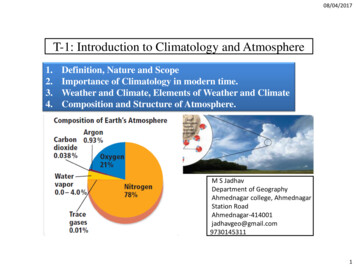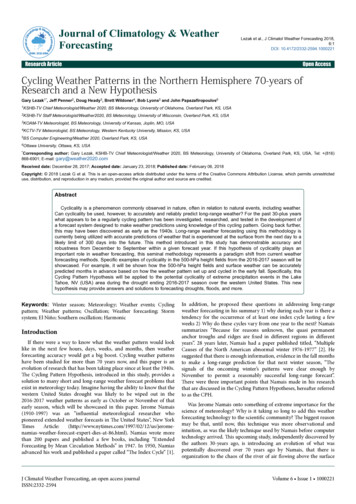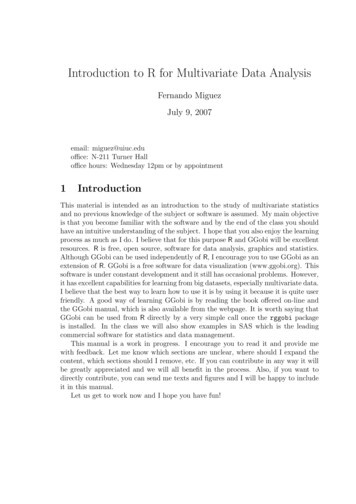
Transcription
08/04/2017T-1: Introduction to Climatology and Atmosphere1.2.3.4.Definition, Nature and ScopeImportance of Climatology in modern time.Weather and Climate, Elements of Weather and ClimateComposition and Structure of Atmosphere.M S JadhavDepartment of GeographyAhmednagar college, AhmednagarStation 1
08/04/2017CLIMATOLOGY-DEFINATION, NATURE AND SCOPEThe study of the Earth falls into four broad categories:I.II.III.IV.The solid lithosphereThe liquid hydrosphereThe gaseous atmosphereThe life biosphereGeo/Litho sphere: The area from the surface ofEarth down to its center is called the geosphere.Atmosphere: The blanket of gases thatsurrounds our planet is called the atmosphere.Hydrosphere :All the water on Earth, includingthe water in the atmosphere, makes up thehydrosphere.Biosphere: The biosphere includes all organismson Earth as well as the environments in whichthey live.2
08/04/2017 Climatology: Climatology studies the gaseous atmosphereClimatology is the science of climate which studythe Physical state of the atmosphere:--over a specific region--during a specific period--on the basis of climatic data Climatology is compounded of two Greek words .,Klima and Logos--Klima- meaning inclination that islatitude--Logos-meaning science of study3
08/04/2017 So, climatology is a science that seeks todescribe and explain: the nature of climate why it differs from place to place how it is related to other elements of thenatural environment and human activities It is the study of the verities of climates foundon the Earth and their distribution over thesurface of the Earth4
08/04/2017CLIMATOLOGY AND METEOROLOGY Climatology is closely related to meteorology Meteorology deals with the day to day atmosphericconditions and their causes Meteorology is defined as the Physics of theatmosphere Meteorology uses the methods of Physical science tointerpret and explain the atmospheric processes Meteorologically it deals with the meteorologicaltechniques and geographically it deals with the spatialaspects of climatic phenomena Climatology collects and interpret the data observed bymeteorology to investigate the spatial patterns of climateand its interaction.5
08/04/2017CLIMATOLOGY AND GEOGRAPHY Since geography studies the Earth as the habitatof Man it is closely related with climatology; Climatology studies the atmospheric conditions Geography studies the spatial distribution ofthese climatic condition Through the study of climate, it serves the ends ofgeography, while the means employed by it are thoseof meteorology Climatology is a science whose methods arestrictly meteorological and whose aims andresults are geographical.6
08/04/2017DEFINATIONS OF CLIMATOLOGY Climatology is the science of climate whichstudy the Physical and spatial state of theatmospheric conditions According to Critichfield: ‘climatology is the science that seeks to describeand explain the nature of climate, how it differsfrom place to place and how it is related to man’sactivities.’ According to Austin Miller: ‘Climatology is that branch of science whichdiscusses the average conditions of weather.’7
08/04/2017 According to Koppen and De Lang: ‘Climatology is a summery, a composition ofweather conditions over a long period oftime.’ According to Thornthwaite: ‘Thornthwaite broadens the scope ofclimatology and suggest that it is the studyof the atmosphere as well as the Earth’ssurface.’Climatology is the science of studying long-term weather trends. Its focus is on averagesof weather and climatic conditions over a long period of time in local, regional and globallocations8
08/04/2017Nature of Climatology:1. Descriptive2. Dynamic3. Scientific4. Interdisciplinary5. Applied6. Complex9
08/04/20171. Descriptive Nature: In ancient period, Greeks geographers study and describe nature ofatmosphere and its influence on human health and culture. Hippocrates(BC400), in his written document “Air, Water and Place”where he descried the influence of climate on health. Theophrastus described different aspects of wind Ancient Greek described three temperature zone based on latitude i) tropical zone, ii) temperate zone, iii) frigid zone The knowledge of weather and climate up to 16th century wasdescriptive. Because qualitatively observed data and description bynon-professional individual.2. Age of Discovery and Exploration: (15th to 16th) Dynamic Discovery and exploration of new areas and there features ofweather and climate. Study of weather and climate out side the Europe.10
08/04/20173.Scientific Nature: (Period Scientific Analysis) Climatology as science blossomed in 17th century when fewinstrument invented to measure climatic variable. Measurement and recording of temperature started with inventionof thermometer by Galileo In 1593 and by Santorre in 1612. Measurement of Pressure started with invention of barometer byTorricelli in 1643. availability of data on temperature and pressure leads toformulation of few laws about atmospheric condition.Ex .Francis Bacon’s treatise on wind in 1662, Boyle’ law about the airpressure and atmospheric gases.Hadley’s cell model on tropical circulation in 1735 know as HadleyCell11
08/04/2017Period of Regional Description: (18th and 19th ) This period is characterized by study of weather phenomenon atregional and global levels Efforts were made to preparer maps of the countries, continents,and glob. Depicting climatic variables like insolation, temperature, airpressure, and wind, atmospheric disturbances, precipitation etc. Description of all variable of climate and weather of differentregions of world. Luke Howard, 1803, presented well documented on classificationof clouds. IMC : (International Meteorological Committee) in 1895. WMO: World Meteorological Organization- publishedinternational Clouds atlas. Alexander Von Humboldt in 1817 prepared World map of meanannual temperature using isotherms12
08/04/2017Interdisciplinary- Applied and Complex:Modern nature: Period of Modern Climatology (20th century): climatology reached to study upper circulation and weatherphenomena , information obtained through advanced techniques.Period was marked by1. Advancement in techniques to obtained detailed regular climatic data.2.3.4.5.Concentration on classification of world climate.Concerned about the climatic changes.Weather forecasting.International cooperations to tackle the future problems ofclimatic changes at local, regional and global levels caused mainlyby anthropogenic factors.*Stratosphere and Ozone layer discovered in 1902,1913 respectively*Jet Stream during IInd Word War*Satellite Climatology as new branch and first meteorological satelliteTIROS 1, SUA launched in 1960.*Decade:1940- Characterized as development of Synoptic Climatology.*Schema of Classification of World Climate-Waldimir Koppen, Geigger Pohi C WThornthwaite13
08/04/201714
08/04/2017 IPCC and concentration on the study of green house gas as cues ofthe increase of global mean temperature by 20c above meanglobal temperature of pre-industrial period by 2030A.D. It will lead to the drastic climate changes affecting all the biota. The climate change will be the major agenda in the presentcentury.Nature of Climatology:1. Descriptive2. Dynamic3. Scientific4. Interdisciplinary5. Applied6. Complex15
08/04/2017Scope of Climatology: Content or Scope of any discipline largely depend on its aims andobjectives. The scope covering all the contents of climatology may bedescribed through its major Branches i.e . Physical and Dynamic climatology Regional Climatology Applied Climatology16
08/04/2017 Physical & Dynamic climatology:Physical climatology:--deals largely with energy exchanges andphysical processes.Dynamic climatology is more concerned with atmospheric motionand exchanges lead to and result from that motion- seeks to explain the factors responsible for bringing out thetemporal and spatial variations in heat exchange, moistureexchange and air movement-- Physical climatology is closely related to meteorology-- Physical climatology is a main aspect meteorology from which mostof its basic principles are drawn-- the focus is on:i.The study of solar energy- its transformation at a location and itstransfer through the atmosphereii. The complicated patterns and exchange of energy from one phase toanother- from solid state to liquid state and from liquid state to vaporand vice versa17
08/04/2017 Dynamic climatology: --is global in scope--it studies the thermodynamic processes in theatmosphere and the resultant atmospheric motions--it investigate the impact of changes in various physicalparameters on climate--this branch of climatology includes:i.ii.The effect of the increase of greenhouse gases inglobal temperaturethe role of mountains in determining the dynamics of theatmosphereAn investigation into sea-surface temperature18
08/04/2017 Synoptic climatology:--deals with local or hemispheric climate from the view point of atmosphericcirculation--different circulation patterns lead to differences in climates--it studies the relationship between circulation features and severe weatherconditions-E.g.- the effect of El Nino and La Nina in creating severe weatherconditions Regional climatology:-- This branch of climatology seeks to determineand describe the various types of world climates--it is also known as descriptive climatology because it is concerned with theidentification of important climatic characteristics and the interaction of weatherand climatic elements upon the life, health and economic conditions of thepeople and areas19
08/04/2017 Applied climatology:-- This branch of climatology is concerned with the application of theclimatological knowledge to practical problems-- It analyses the relationship of climatology toother sciences--The main purpose is to find out the ways and means to make use of ourknowledge of climatic elements for the betterment of human life on the Earth20
08/04/2017THANH YOU21
Modern nature: Period of Modern Climatology (20th century): climatology reached to study upper circulation and weather phenomena , information obtained through advanced techniques. Period was marked by 1. Advancement in techniques to obtained detailed regular climatic data










